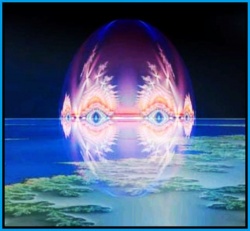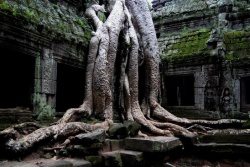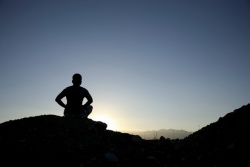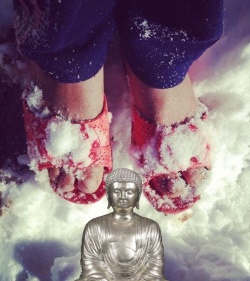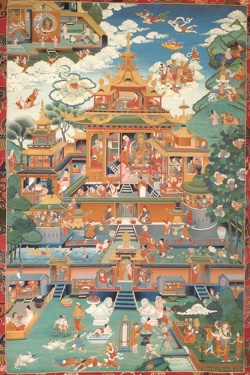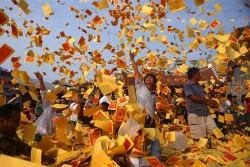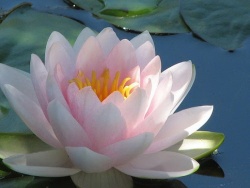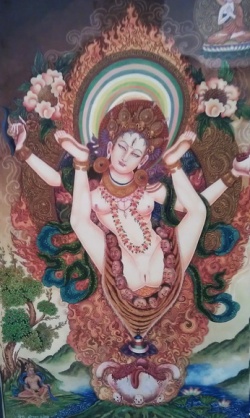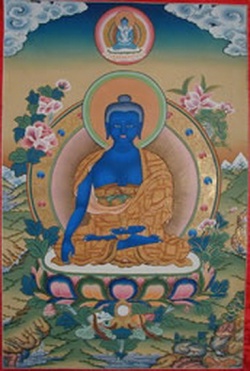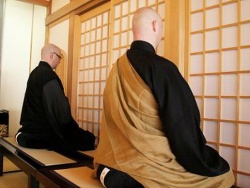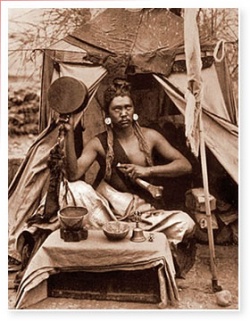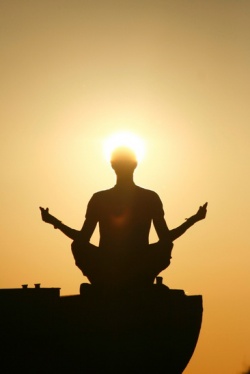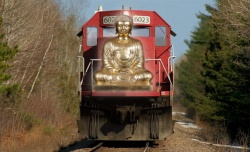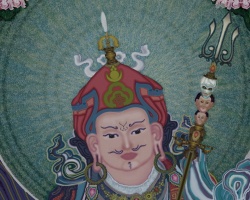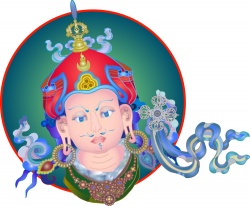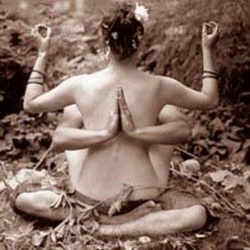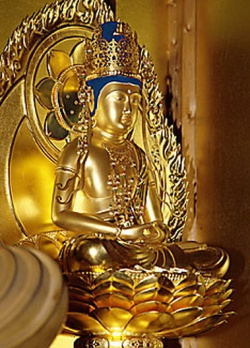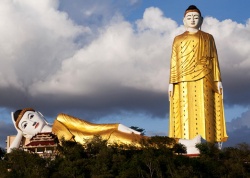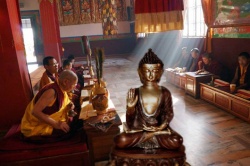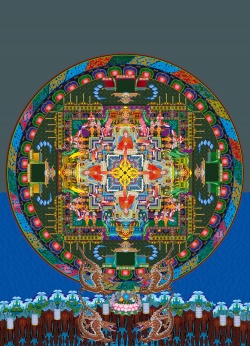Buddhist Funeral Cultures Of Southeast Asia And China
Buddhist Funeral Cultures Of Southeast Asia And China
edited by
Paul Williams
and
Patrice Ladwig
Preface
The centrality of death rituals has in anthropologically informed studies of Buddhism been little documented. The current volume brings together a range of perspectives on Buddhist death rituals including ethnographic, textual, historical and theoretically informed accounts, and presents the diversity of the Buddhist funeral cultures of mainland Southeast Asia and China. It arises out of the University of Bristol’s Centre for Buddhist Studies research project Buddhist Death Rituals in Southeast Asia and China, funded by the UK’s Arts and Humanities Research Council (AHRC). This project involved extensive new research in Thailand, Laos and China. Other items from that project included several public exhibitions, extensive stills photographs and several video films. The project team produced two 30-minute films on the Ghost Festival in Laos and China, one on urban funerals in Chiang Mai (Thailand) and several shorter clips dealing with funeral cultures in Laos, Thailand and China. Most of this material (and an extensive bibliography on the topic) is available free of charge from the project website located at the webpage of the Department of Theology and Religious Studies (Centre for Buddhist Studies) at the University of Bristol.
It gives us great pleasure to thank the AHRC for the funding that made this project possible. We also want to thank all those who contributed in different ways to its success, including those who took part in making and appearing in the films, all the contributors to this book and, in particular, the three research fellows/assistants who were involved during the lifetime of the project: Rita Langer, who originally conceived the project and saw its birth as well as undertaking some of the research involved; Patrice Ladwig, who was the research fellow throughout the body of the project and undertook a great deal of the research and organisation involved; and Ailsa Laxton, whose wonderfully efficient organisation and also expertise in putting on exhibitions came at just the right time. Thank you all so much not only for your impeccable efficiency but also for the sense of humour that made working on this project so much fun. We should thank, too, Ingmar Heise, who held the AHRC PhD research bursary for the project, and his supervisor, our colleague John Kieschnick. We would also like to thank John Kieschnick for preparing the Index. Thanks as well to our other colleague, Rupert Gethin, for all his encouragement, support and help, and to the University of Bristol for providing such an agreeable base for the project.
The project would have been impossible without all the people in Laos, Thailand and China who welcomed us into their homes and temples and allowed us to participate in their lives. In Laos we would like to express our gratitude to all the families and temples in Vientiane and Luang Prabang that aided us in our research, especially Duang Lattana Suphantong and Gregory Kourilsky, Khongma Pathoummy, and Michel Lorrillard and Achan Keo Sirivongsa of École Française d’Extrême-Orient (EFEO) Vientiane. Thanks also to the Section of Religion of the Lao National Front for Reconstruction in Vientiane and Huaphan province. In Chiang Mai we would like to thank Apinya Fuengfusakul, Nawin Sopapum and Suebsakun Kidnukorn for excellent hosting and research assistance. On the Chinese side we would like to express our gratitude to Zhang Han, Professor Xu Jinding of Quanzhou’s Huaqiao University, Mao Wei and his friends and the monastics, monasteries and laypeople of Quanzhou. Thank you Laura Morris and all those involved at Cambridge University Press for accepting this book and also for its production. Funeral rites may not be a laugh a minute, but we hope the results – the ‘outputs’, as we are nowadays expected to call them – will still be informative, stimulating of further scholarly research, and perhaps even entertaining.
Patrice Ladwig
and
Paul Williams
Chapter 1
Introduction: Buddhist funeral cultures
Death at the centre of Buddhist Culture
The statement that ‘death is the origin and the center of culture’ (Assmann 2005: 1) might at first sight seem like a simple generalisation that misses out on many other aspects of culture. However, when the study of death is not simply reduced to a rite of passage, we believe that approaching Buddhist cultures through their ideas, imaginaries and practices related to death can help us to understand crucial facts that reach beyond the domain of death and dying. First, death offers a unique departure for understanding the relations between people, monks, ritual experts and other entities that are commonly labelled as ‘the dead’, but can in fact comprise a multitude of entities of various ontological statuses. Second, death reaches out into such diverse domains as agricultural fertility, human reproduction, political cults and the economy and therefore constitutes a total social fact (Mauss 1990). Jan Assmann’s statement also has a particular relevance for the history of Buddhism. Death indeed was and is at the centre of Buddhist culture and has on a ritual, ideological and even economic level played a crucial role in its development and spread. Death was from its beginning an event that was seen as particularly central to Buddhist interests. Throughout Asia it has always been recognised that Buddhists are specialists in death. One of the things that attracted Chinese (and Tibetans, for that matter) to Buddhism was its clarity about what happens at death, the processes needed to ensure a successful death – the welfare of the dead person and his or her mourners – and its clarity about what happens after death and its links with the whole way someone has lived their life. No other rival religion in Asia had at that time such clarity. It was a major factor in the successful transmission of Buddhism from its original Indian cultural context.
Why was Buddhism so successful in explaining death? Death was written into Buddhism from the beginning. It is universally accepted in the various hagiographies of Siddhārtha Gautama (died c. 400 bce), the wealthy aristocrat who was to become the so-called ‘historical Buddha’, known as Śākyamuni, that one of the things which first gave him the existential crisis that led to his spiritual search was the sight of a dead man. This came as a shock, but much more was the shock when he applied the lesson to himself. He too would one day be as this manwas – dead. The breakdown which resulted took from him all taste for the pleasures of life. Aware that there were others in north India who felt like he did, and who sought a state of being in which death would have ceased to be a problem for them, he renounced his life of luxury (and his wife and child) and joined them, a ‘drop-out’. After many years in the forest, a homeless ascetic who lived on alms and practised physical austerities and deep meditation, he came to understand that if he could see in the deepest, most life-transforming way things the way they really are then death would no longer be anything to him. Seeing things that way, Buddhists hold, made Siddhārtha Gautama the Awakened One, the Buddha. This is a matter of the mind, understanding reality as it is, not physical asceticism but mental comprehension brought about through deep meditation. And that awakening was accompanied, so Buddhist tradition holds, by a triumph over Māra, the Buddhist ‘tempter’, whose very name suggests etymologically a personification of death.
So the Buddhist path from the beginning lay in a confrontation with death, at least for the spiritual virtuosi who could manage it. Doctrinally and philosophically speaking, there is also an intimate link between the notion of impermanence (Pali: anicca) and death. Things naturally arise and fall in accordance with impersonal causal processes. We suffer, we suffer all the time – including the unbearable but inevitable suffering of death – because we try to fix the processes of change, and we crave changeable things which in their cessation are bound to cause the one who craves them to be miserable. Applied to our lives, we are naturally bound to die, just as throughout life we were really inexorably dying all the time, from moment to moment, or even split moment to split moment. Our craving for our own permanence – something which is quite impossible – is one of the crucial factors that entail our deep existential suffering and misery. We are bound to die, and release comes when we let go in the deepest possible way and cease at even a subliminal level from resisting our inevitable impermanence. For, the Buddhist tradition argues, there is nothing about us unenlightened and hence inevitably suffering folk that could ever stand firm against the inexorable process of dissolution.
In this view, death is overcome through its deep acceptance, and its acceptance involves seeing that it is constantly occurring, from moment to moment to moment. Buddhist philosophy elaborated in great detail the different types of impermanence, and the complex causal connections between impermanent events. Impermanence and death are of the very essence of Buddhism. And it is this centrality of impermanence and death in Buddhism, reflected in the Buddhist doctrinal emphasis on change and absence of enduring identity – for death is a constant occurrence, we are really in many ways dead even while we are alive – when expressed in living cultures where close reciprocal relationships with the dead ancestors are essential to social identity and cohesion, that we shall see reflected in the studies contained in this book.
The dead between ‘Doctrinal Absence ’ and ‘ Anthropological Presence’
As many contributions in the present volume show, the dead continue to play a role in the life of the living; not only in the form of memory, but as ‘active’ members of a family or a community. They can live on in the form of other entities, as ancestors, spirits, ghosts. Therefore, what counts as dead, as being and agency has to be explored in very specific contexts. As Holt (2007) puts it for Sri Lankan Buddhism, the dead are ‘gone, but not departed’. As classical and recent anthropological studies of death (Hertz 1960; Metcalf and Huntington 1991) have shown, in many societies death is usually conceived as a process of transformation, and less as the end of the agency of a deceased person, as is very often assumed in biological, ‘Western’-inspired understandings. And yet the idea of ‘the dead’ as active members of the community, while undoubtedly very much present in the cultures covered by this book, provides an obvious paradox for anyone whose exposure to the study of Buddhism has been entirely or primarily its doctrine. For from the beginning, we have been taught, Buddhism holds that the dead have been reborn (or reincarnated – the attempt sometimes made to suggest some sort of difference between the two in ‘Buddhist English’ has little to recommend it). Whether the dead are reborn immediately after death, as is the doctrinal position of the Theravāda Buddhism of Southeast Asia, or there exists a short period of up to forty-nine days before rebirth, as is common in the Buddhism of e.g. Tibet or China, makes little difference. The fact is that soon after death the dead have gone beyond recall, reborn perhaps as happy beings known as ‘gods’ (deva), or as warlike ‘anti-gods’ forever jealous of the gods, or perhaps once more as humans, or non-human creatures such as animals, fish, cockroaches or wiggly worms, or hungry ghosts, or worst of all reborn in one of the many terrible hells of Buddhism in accordance with the moral quality of their past deeds while alive (‘karma’).
Of course, it is perfectly possible that one’s dead family members have been reborn close to their living descendants, and hence are still capable one way or another of being in a dependence relationship with the living. But once more the majority doctrinal position of Buddhism has been to deny that these beings could be seen as actually still being our former family members who have passed on and to whom we hence preserve our familial duties of former times. This is because (we are told in so many introductory books on Buddhism) the Buddha did not hold that the reborn being is literally in all respects the same as the being who died. The reborn being is certainly not in any meaningful sense the same person as the one who died, and this point is recognised quite explicitly in several influential Buddhist philosophical traditions (Williams 1998: Chs. 3, 5). A cockroach cannot be the same person as one’s grandfather.
The link between the ‘reborn being’ and the ‘being that died’ is explained in terms of causal dependence, where karmic causation is held to be a central factor in holding the whole process together. And it is essential to Buddhist doctrine that with causation there is absolutely no need for some sort of permanent, unchanging, enduring self-identical bearer of personal identity – a ‘Self’ – to link the one who dies and their rebirth (Collins 1982). All that happens is that at death the psychophysical bundle, made up out of a stream of physical events, sensations, conceptual activities, various other mental events including crucially one’s intentions, and that awareness which is necessary to any conscious experience (i.e. the five classes of psychophysical events known as the ‘aggregates’) reconfigures. Doctrinally speaking, a living being is nothing more than a temporarily structured configuration of physical events, sensations, events of conceptualisation, various mental events such as intentions, and awareness, without any enduring Self (Pali: attā; Sanskrit: ātman) to glue him or her all together. Even when alive these aggregates (Pali: khandha; Sanskrit: skandha) form a flow, a stream, with no stability save that provided temporarily by the structuring causal force of previous actions. At death one configuration breaks down and another configuration takes place. Thus the person is reducible to a temporary bundle of events where all constituent events are radically impermanent, temporarily held together through causal relationships. Thus even if one’s family members have been reborn in close relationship to their grieving family, this doctrinal position would entail that the rebirth cannot in any meaningful sense preserve enough identity to entail the normal social relationships and duties incumbent upon close or even fairly distant family members. The dead may be all around us, but they are no longer our dead.
And yet, as we shall see in the collection of papers published in this book, anthropological work in cultures where Buddhism plays a major part shows that the doctrinal scenario represented here must obviously be transformed and reinterpreted where reciprocal relationships with the dead ancestors is an essential part of living as a member of the group and its own social identity and cohesion. These dead ancestors are frequently felt to be present and still to be themselves for sometimes a considerable, if not indefinite, time after death, certainly more than forty-nine days. They continue to be present, albeit as transformed entities. Because Buddhism is in a society it necessarily performs a social role, and that role (a role of all religions) is one of caring and coping for the needs of society. As society also includes the dead, Buddhist funeral cultures comprise a multitude of ritual and other activities focusing on those who remain alive in some sense despite being considered dead. The deceased have to be cared for, they have to be fed, to be appeased or simply to be remembered as the duties to and relationships with the dead are essential to the flourishing of many, perhaps all, societies.
Imagining death and the ritual process
With the expression ‘Buddhist funeral cultures’ we do not strictly limit ourselves to the domain of ritual or text, or an original idea of death in early Indian Buddhism. We understand the term in the sense of an imaginary, the latter term here denoting not something false or fantastic, but – similar to Steven Collins’ notion of the ‘Pali imaginaire’ (1998: 72ff.) – as a concept referring to a capacity or faculty of the mind dealing with death and the dead. This imaginary is also created and expressed in ritual and everyday practices. Farrer (2006) has used the term ‘deathscapes’ in a very similar sense. On the one hand this can refer to concrete spaces of death like cemeteries, crematoria, monuments or, in general, material aspects of death (Sidaway and Maddrell 2010).On the other hand, this can deal with the complex conglomerate of abstract discursive and subjective spaces which death ‘inhabits’: texts, stories, emotions, but also rites and social practices are just a few examples. These stand in constant dialogue with the concrete spaces of death mentioned before. Due to these multiple links of death to various fields and domains, it cannot be understood as a timeless and universal idea or concept. Because ‘society is not only made up of the living but also includes the dead’ (De Coppet 1981: 198), death reflects the larger changes in society and history. Rituals, death imaginaries and deathscapes are open to transformations caused, for example, by political changes, sectarian divisions or religious purifications. In the chapters dealing with death and spirits in Laos (Bouté and Ladwig: Chapters 5 and 6) and
Heise on the Chinese ghost festival (Chapter 10) we see how socialist revolutions have led to certain rationalisations or even ritual restructurings that still have an influence in the present. Another example of the change of funerals is how the civil war in Sri Lanka has also left its traces in the preachings performed at funerals (Kent 2010). Robinne’s chapter on theatre plays staged at a monk’s funeral in Burma (Chapter 8) show that these performances are also commentaries on the present state of affairs. Besides dramatising the emotions of loss and mourning, imposed government propaganda (including the caricaturing of Westerners, for example) has been integrated into these plays. However, also a subversive and subtle critique of the Burmese junta can be aired in these performances.
What one encounters in the field, especially when dealing with local Buddhist funeral experts, is the claim that the rites – as prescribed and normative forms of behaviour – have changed little. Although Langer in her contribution (Chapter 2) proposes for the Sri Lankan case that ‘death rituals appear to be quite resilient to change’, closer inspection through a historical perspective often reveals a different picture. As in Chirapravati’s contribution (Chapter 4), this might be expressed through a change in the role of objects in funerals, but might also be visible through deeper ritual restructurings. However, taking our informants seriously in that matter also means acknowledging that the imaginary of continuity, or the non-change of certain elements of these rites, is crucial for them. In the sense of Langer’s quote above, death is considered a serious issue that demands regulation and the weight of a continuous tradition to be dealt with.
Death is a total social fact that cannot be cut out and analysed as a single standing social event; it is rather a starting point of a long transformative process and an initiation into an afterlife (van Gennep 1960) of various deathscapes. Many studies of the volume therefore focus on the collective experience of death and how it is dealt with ritually. Death, as a disruption, the occurring of a sudden absence and non-presence, poses a threat to the social and cosmic order. Rites can be understood as instant and prophylactic measures to handle this exceptional situation and regain order. This process is most clearly expressed in Robert Hertz’s classical study on the collective representations of death:
- The brute fact of physical death is not enough to consummate death in people’s minds: the image of the recently deceased is still part of the system of things of this world, and loses itself from them only gradually by a series of internal partings. [. . .] Thus, if a certain period is necessary to banish the deceased from the land of the living, it is because society, disturbed by the shock, must gradually regain its balance. (Hertz 1960: 81–2).
This shock, or state of exception caused by death, is a confrontation that calls for ritual explication, but also a ritual smoothing of the transition. As Faure (1991: 184) has attested for Chan Buddhism, ritual is a form of mediation that ‘simultaneously hides and? reveals death: it marks its apotheosis, but also diffuses or defers its suddenness by turning the corpse or its substitutes into signifiers’. Ritual in that sense structures the space and time necessary for the movements and transformations of the corpse (Parkin 1992). This transformation of the corpse involves a number of stages such as the preparation and laying out of the corpse, recitation of texts, procession, and the final transformation of the corpse through incineration or burial. This process is accompanied by a ‘care for the dead’ by the living by providing food, merit, prayer and so forth. Obviously, there are large variations to this pattern. Even in one culturally relatively homogenous community differences caused through status distinctions can be huge: a monk has a very different funeral from a well-off layperson, and again this one is differentiated from the poor peasant. Langer’s contribution starts with the (rhetorical) question ‘Is there such a thing as Theravāda Buddhist funeral?’, to which Tam in his contribution on Southeastern Chinese funeral rites (Chapter 11) gives us an indirect answer. For him, ‘in the end defining a “standard” Chinese Buddhist death ritual is not a particularly useful project’ (a similar point made for Tibet in Gouin 2010). It is not about the search for an original, historical blueprint of these rites, nor about defining a standard. So does the search for common patterns or a comparison between larger categories make sense at all?
Comparisons, categories and differences
Large-scale comparisons are, since the theoretical decline of grand narratives and the influence of deconstruction, a bit out of fashion. Recent research on the basic categories of Buddhist studies such as ‘Theravāda’ or ‘Mahāyāna’ have been critically scrutinised (Skilling and Carbine 2011). However, Williams argues that despite doctrinal diversity one can with appropriate caution speak of Buddhism and Mahāyāna as categories. Buddhism in that sense has ‘doctrinal diversity and (relative) moral unity’ (Williams 2009: 1). Although we cannot offer in this volume a systematic comparison between mainland Southeast Asian Theravāda Buddhist funeral cultures and Chinese cases, we believe the outcome of such an endeavour depends on the framework and scope of comparison. There is a whole spectrum between deconstructing categories such as Theravāda through, for example, the study of in-depth micro-histories, and the reflexive conceptualisation of categories that can serve as a basis for systematised and general comparisons. Neither the contributions in the volume nor this introduction deliver a systematic comparison, but we suggest that it is worth paying attention to several potential fields of comparison. First, there is a certain historical and regional affinity. Mainland Southeast Asia, especially the mountainous border regions of Yunnan, Laos and Burma, are a meeting place of both regions (Evans et al. 2000). Laos, for example, represents the eastern limit of Theravāda’s expansion into Southeast Asia. In relation to funeral cultures, Gregory Kourilsky (2012) has, for example, suggested that certain elements found in the Lao Ghost Festival have clear parallels in the Chinese and Vietnamese festivals. Ladwig’s and Heise’s chapters deal with these festivals in their respective contexts and can serve as comparative examples. Here, the textual sources such as the story of Mulian in China and the Theravāda Moggallāna point to common origins that are ritually interpreted in different ways. Kapstein (2007) has also looked at the transformations of this narrative in the Tibetan-Chinese context.
A second example for the potential of comparison in the domain of funeral cultures can be advanced with regard to the importance of ancestor cults. Bouté’s contribution on the Phunoy – a Tibeto-Burman minority living in the borderlands of Laos and China – suggests that their ancestor cult at least bears some resemblance to Chinese practices. The same can be said for the descriptions of bad or ‘green’ death, which also contains a comparative potential (see further below). We do not want to suggest that mainland Southeast Asian Buddhism is simply a mixture of Chinese and Indian influences, but that some partial connections exist and are worth following up in future research. Peter van der Veer’s (2009) comparison between India and China as civilisations can here serve as a model. Another level of comparison inside the Theravāda tradition is advanced by Langer. Looking at funerals and chants in Sri Lanka, Laos, Thailand and Burma, her comparative examination looks for ‘core elements’ of these rites and their variation. Langer gives us an overview of these elements: the presentation of a rag-robe (paṃsukūla), the giving of merit, the asking for forgiveness and religious wishes. She then discusses the ‘optional elements’ like Abhidhamma chanting and the use of protective parittas.With reference to Lévi-Strauss’s idea of bricolage, Langer understands the performed rites and the chanted texts as a toolbox from which certain elements can be drawn. Although religious specialists might point to the coherence of chants and their genealogy from the Pali canon, variation and individual appropriation is rather the norm than the exception. Here, the canon (for the Theravāda case) and the chants used in funeral rites, are less a fixed compendium of texts, but rather an ‘idea’ that is efficacious through its imagined homogeneity and continuity (Collins 1995). Despite these variations, Langer – through a meticulous analysis of funeral chants – succeeds in uncovering common patterns across a vast temporal and spatial spectrum perhaps also based in the long tradition of regular exchanges between Southeast Asian and Sri Lankan Buddhism. Langer concludes her contribution with the statement, ‘On the whole, Theravāda monks from Thailand would find little difficulty in joining into a chant of monks from Sri Lanka.’
Comparison, however, is also based on markers of difference. In contrast to the chapters dealing with Theravāda in mainland Southeast Asia, the two contributions by Tam and Chen (Chapters 11 and 12) both refer to the ‘imperial metaphor’ (Feuchtwang 1991) that becomes visible, for example, in the passport-like documents that the deceased need in order to cross the boundary to the afterlife. This is completely absent in the instance of Theravāda and the Chinese cases are marked by a different idea of orthopraxy. For Feuchtwang (2009: 103), China has ‘a civilization of the government of conduct, its correction, exemplary performance and enforcement’. Although Ladwig has found similar ideas of the bureaucracy of hell in Laos that could be related to the imperial metaphor, the difference between them is still large. There is no bank of hell among Theravāda Buddhists and no burning of spirit money or houses can be observed. The sacrificial economy connecting the world of the living and the dead follows a different logic. The latter point is also visible in the different roles of monks. Whereas in China expert laypeople or half-official monks can also officiate at funerals (see the xianghua heshang in Tam’s chapter), the Theravāda sangha seems to have a much more clearly defined position in death rituals. Without them, the contact to the dead is difficult whereas in China burning money or paper replicas of offerings can be done without the intermediary role of monks. On the whole, our volume has more contributions regarding mainland Southeast Asia, but the excellent volumes edited by Cuevas and Stone (2007), and Watson and Rawski (1988) present more information on East Asian funeral cultures. The material presented there can be contrasted and compared with the Theravāda cases presented here.
The localisation of Buddhist funeral cultures
The majority of contributions look at Buddhism as being very much ‘of a place’, as all Buddhism really is and to which all study of Buddhism needs constantly to return. In cultures where Buddhism has been predominant, the relationship between Buddhist doctrine and social behaviour is a very complex one indeed (see, for example, Gombrich 1971). But it would be quite wrong to approach Buddhism as it occurs ‘in a place’ (and when does it not occur in a place?) with some sort of legislative model of what should happen or what Buddhists must do. Given the large variety of what has been called ‘Buddhisms’ (Ling 1993), we do not intend to reconstruct an original death ritual and then look at the local variations that have evolved. Instead, we want to examine the creative local appropriations that in a manner of a bricolage make use of certain elements already apparent, for example, in early Buddhism. The Mahāparinibbāna Sutta, recounting the last days, death and the funeral of the Buddha (cf. Strong 2007), could in this light be seen as a textual toolbox out of which certain elements are appropriated and are then translated into ritual practices constituted by partially prescribed, but also improvised actions accommodated to a local context.
Given the centrality of funeral rites in the development and spread of Buddhism, many of the contributions give us a detailed image of the localisation of Buddhism in the field of funeral culture. The interaction with pre-Buddhist ideas and cosmologies of the dead are, for example, exemplified in themultiplicity of concepts of what constitutes a person and how this entity, substance or conscience is transformed in the course of death. Conceptualising this interaction of Buddhist concepts and their transformation on the local level in a specific setting has a long history in anthropology and Buddhist studies. Discussions on the interaction of ‘great and little tradition’ (Obeyesekere 1963), the structural division of labour of Buddhism and spirit cults (Tambiah 1970), or more generally speaking notions of syncretism, have all examined the transformation of Buddhism on the local level. These discussions can also be applied to Buddhist funeral cultures.
However, like the concept of comparison discussed above, most of these discussions are currently somewhat out of fashion through the influence of a flexible hybridism model of culture. Shaw and Stewart (1995: 7), for example, propose that seeing a ritual or religion as syncretic ‘gets us practically nowhere, since all religions have composite origins and are continually reconstructed through ongoing processes of synthesis and erasure’. Historical studies of Buddhism have proposed a less radical, but still similar, view. Buddhism was from its very beginning linked to a variety of local cults and entities that have been subsumed under the category of spirits or ancestors, as for example DeCaroli (2004) has shown. Through this flexible approach to funeral culture we can understand that there were also specific openings in Buddhist cosmology that allowed for an easy integration of indigenous cults. Reynolds (1976: 207) suggests that ‘one of the reasons Buddhist cosmography fitted so well into mainland Southeast Asian societies is that it included a place for the creatures of animism’. Given the complex switches of ethnic and religious affiliation in mainland Southeast Asia (Leach 1954), this openness has probably contributed to Buddhism’s successful spread.
Despite the widespread scepticism about concepts that try to understand the relationship of Buddhism and indigenous culture, the problem does not disappear. Just imagine a ‘first contact situation’ in the case of funerals. How did monks accommodate to a local situation? How did they enter into the local funeral traditions and what roles could be appropriated? In his contribution, Chen employs a historical perspective and through archaeological evidence reconstructs the meeting of Chinese Buddhist funeral culture with local burial customs. Like Schopen (1997), Chen argues that in order to avoid social censure, monks had a tendency to adjust their practice to local values. Chen also looks at current burial practices, in which monks, compared to the Theravāda cases we have discussed before, have a rather limited role. Moreover, he proposes that we have to look at a triangular relation that besides laity and san˙gha also includes funeral specialists, which in contemporary Taiwan still play a major role. An interesting case that moves outside the division of ‘great and little tradition’ is described in Formoso’s contribution. He analyses the activities of Chinese funeral associations in Thailand and Malaysia that collect the bones of the victims of bad death. The activities and rites give rise to a very exceptional case of interethnic funeral cooperation. Although there are also differences and interethnic problems associated with the rite, Formoso thinks that ‘Buddhism whatever the doctrinal differences between Theravāda and Mahāyāna traditions, is a key factor to bridge the differences between the groups in contact’. We see here again how Buddhism delivers a flexible template that can operate in various contexts and lives on its multiplicity of concepts.
Coming back to syncretism, we find in David Gellner’s anthropology of Buddhism a line of argument that recovers some value in the concept of syncretism, namely as defining a certain hierarchy and interpretational sovereignty. Concerning the interaction of Buddhism and local traditions, he states that ‘in order to find cohabitation acceptable, Buddhist specialists require that these other systems acknowledge Buddhism as the supreme overarching system, and as a path to salvation, and that their practices do not conflict too blatantly with Buddhism’s own teachings’ (Gellner 1997: 323). Applying Gellner’s insight to funeral cultures results in what could be called an ‘ordered multiplicity of concepts’ instead of a random cultural hybridity. A good example for this ordered multiplicity can be found with reference to the immaterial components of a deceased person that features in many of the contributions. Although references to viññāṇa (Pali: ‘consciousness’) or its equivalent are to be found in most Buddhist funeral cultures, there are substantial overlaps with pre-Buddhist and indigenous concepts of soul, spirits and ancestor to be found. In contributions by de Mersan (Chapter 7) and Bouté (Chapter 5) we see multiple concepts of ‘soul’ (a term Buddhologists always try to avoid), or what survives death at work in funeral cultures. These concepts do not contradict each other, but open a space of interpretation. This complex amalgam of various concepts is well documented in Robinne’s chapter. The theatrical performances that accompany the funerals of monks are a way of rewriting the Buddhist canon or filling the gaps, but only ‘when the text’s ambiguity leaves open this space’. In the sense of an ordered multiplicity this interpretative freedom is not random, and in his view ‘these amalgams and confusions cannot be simply attributed to ignorance’. So it is not only that there is in many of the cases described in the volume a survival of certain aspects of a deceased person – a feature that was already present in early Indian Buddhism (Gellner 1997: 214; see also Gethin 1998: 159f.) – but, moreover, there is a multitude of ways to conceptualise this aspect of death. What is crucial when looking at these multi layered concepts is that their interaction is not necessarily random, but can be systemic. In many cases this syncretic multiplicity might affirm Buddhism’s hegemony in the funeral business. However, there might also be cases when Buddhist concepts are pushed into the background, as in the case of the Tibeto-Burman Phunoy where there is neither a Buddhist concept of the ‘soul’ nor an idea of reincarnation predominant.
Bad deaths, ghosts and pollution
The fate of the immaterial components of a person is of crucial importance in Buddhist funeral practices. Besides the fact that someone died, it is also important to look at who died in which way. The pollution and dangerousness caused by a normal death is multiplied in the case of a bad death. Chanting and the ‘magical power of words’ (Tambiah 1968) are often considered an indispensable part of a funeral rite and battle the potential pollution caused by death. Schopen (1997: 219) points out that death and pollution have always been central to Hinduism and that certain elements were appropriated by early Buddhism in order to fit into the cultural landscape of Hinduism and avoid criticism and opposition. Although the overarching importance of notions of purity and pollution, for example as proposed in the heavily criticised account of Hinduism by Dumont (1980), is not observable in Southeast Asia and China, the domain of funerals is to a certain extent always marked by pollution. As Davis states in his contribution on Khmer funeral culture (Chapter 3), monks are considered to be socially dead and are therefore equipped to deal with death as an exceptional situation, but the laity is still exposed to the dangers of death. Pollution, according to Mary Douglas’ (2002) study Purity and Danger, is a result of the contact or presence of an anomaly, a break in the flow of things that resists classification and endangers the community. Although death is in some sense completely natural, it at the beginning ‘resists’ integration and is shocking, especially in the case of bad death; a notion widely spread in Asia and understood as an untimely, premature or violent death (Baptandier 2001; Feuchtwang 2010: 135f.). Douglas states that pollution has to be understood as the ‘interplay between form and formlessness’ (2002: 150). Ritual can be seen as the struggle to give bad death a form, work it through and combat pollution.
Several contributions in this volume deal with the case of bad death, but the two cases of ‘ethnic minority Buddhism’ – by De Mersan on the Arakhanese in Burma and Bouté on the Phunoy in Laos – are perhaps most exemplary. De Mersan’s chapter contains an impressive description of a rite called ‘to introduce the word action’ intended to drive out evil forces and spirits in case of bad death. Among the Arakhanese, bad deaths ‘give rise to an immaterial component of a person in search of a base, which therefore endangers the living’. Here the ritual actions redefine the social space and boundaries of the village and the chants purify it and expel evil spirits. Another example of how death threatens the social cohesion and purity of the village is given in Bouté’s contribution. Here, the yearly rites for the ancestors have the main goal of securing the purity of the village and regenerating its potential for fertility of humans and the land. The idea of reincarnation – in popular imaginary perhaps the sine qua non of Buddhist funeral cultures – according to Bouté remains quite foreign to the Phunoy. Ancestor cults are far more important for them due to their protective qualities.
Heise’s and Ladwig’s contributions on China and Laos respectively connect the themes of bad death and ghosts. Ghosts are from a doctrinal perspective often the outcome of bad karma or negative deeds towards one of the members of the sangha, but in practice they are often associated with bad death. Ghosts can point to unresolved conflicts, trauma and bad death; to a life that through violence and untimeliness has not had a proper ending and has yet to be finalised. Persons who have died a bad death are denied the passage and are caught in between the worlds. Nevertheless, ghosts are social
beings that are addressed and play a role in the lives of the living, or indeed can be seen, heard or spoken to in specific contexts and have specific desires. Therefore, one should not approach ghosts as remnants of a ‘primitive belief’, but as important figures of the social fabric. Morris (2008: 31) suggests that ‘ghostliness in Southeast Asia offers itself as an idiom with which to address issues about the difficult delineation of a boundary between the living and the dead’. This is especially exemplified in cases where political violence, war or rapid and forced social change has happened (Kwon 2008; Mueggler 2001). Here, the line between the living and the dead is blurred through hauntings, and ghosts in that sense stand in defiance of binary oppositions such as presence and absence, body and spirit, past and present, life and death (Derrida 1994). The ambiguity exemplified by ghosts calls for ritual action either as part of the ritual cycle (as described by Heise and Ladwig), or demanding even greater ritual action in order to appease, for example, the abandoned souls of soldiers who have never found peace due to their bad death on the battlefield (Kwon 2008).
The materiality of funeral cultures
But not only ritual actions, words and beliefs are topics of research when dealing with Buddhist funeral cultures. Gregory Schopen (1991) can be considered one of the first who seriously took into account the study of certain material evidence in early Indian Buddhism and in recent studies, the materiality of religion has been highlighted as a long-neglected field of inquiry.
Things and objects also have a social life (Appadurai 1986) that can be important for funeral cultures. Objects dealing with the dead are crucial for performing rituals, but also for recalling the presence of the dead. Hallam and Hockey (2001: 7) propose that ‘in the absence suggested by death we find potent cultural materials and strategies including objects, visual images and texts that constitute systems of recall’. The objects dealt with in funeral rites – may they be quotidian things or ritual objects – have a lot to say about how death is imagined and dealt with. It is important what people and texts tell us, but we must not forget that ritual actions are carried out with the objects that often play a crucial role in these performances. Davis, Langer and Chirapravati deal with a specific material aspect of Buddhist funeral culture, namely with the paṃsukūla robe. By looking at depictions of funerals in Thai murals in a historical perspective, Chirapravati is able to detect important changes in Thai funeral culture. Here, the shift from paṃsukūla as rag-robe taken from the dead to an offering of a new robe at Thai funerals attests the transformation of monks from scavengers to recipients of gifts (Schopen 2006: 337). Davis explores the meanings of the paṃsukūla in the Khmer context and proposes that ‘the ritual actions of the paṃsukūla are mirrored in ritual and technical actions performed in other contexts, in which non-Buddhist spirits are controlled and made useful by Buddhist monks’. Langer examines the, at first sight, contradictory modern image of the paṃsukūla with its sources in Buddhist history by looking at the chants associated with it.
The topic of the materiality of funeral cultures is also a topic dealt with by Patrice Ladwig. He focuses on the post-mortem fate of victims of bad death, who among the ethnic Lao become phiphed, a liminal ghost being sharing many characteristics with the peta of the Petavatthu, but also exposing specificities of the local cosmology. Although the ritual discussed by Ladwig has its textual references in Pali Buddhism, he proposes that certain Buddhist key concepts linked to the funeral culture such as the widely discussed transfer of merit are relevant, but can only be understood in relation to Lao notions of food and corporality. The materiality of the offerings given to ghosts has nourishing qualities that largely derive from a local cosmology, but is ritually integrated into the transfer of merit.
Death and the regeneration of life
The role of beings labelled ‘dead’ also becomes important in relation to fertility and the regenerative potential that death contains. Death is, almost on a universal level, a ritual separation from the living, but also a celebration and reproduction of fertility not only in the human domain. In that sense, the ‘rebirth which occurs at death is not only a denial of individual extinction but also a reassertion of society and a renewal of life and creative power’ (Bloch and Parry 1982: 5). Death is always a signifier of the potential breakdown of fertility through finitude and decay and demands ritual action aiming at reestablishing order and reproduction.Hertz already noted in his comparative study on death that, ‘In establishing a society of the dead, the society of the living regularly recreates itself’ (Hertz 1960: 72). Many of the funeral cultures discussed in the book are still predominately situated in societies that make their living out of or from agriculture. Here, the fertility of the land is intimately linked to the dead as protective spirits or ancestors. Paul Mus (1975) already proposed this link of Buddhism with Southeast Asian ‘cadastral cults’. Indian religions took root in Southeast Asia by establishing a link to chthonic forces and fertility. In his contribution on Khmer funeral culture, Davis conceptualises the monk as a master and farmer of the dead who is capable of controlling and containing the worlds of spirits. With reference to the paṃsukūla robe and its role in ritual practice and the imaginary of death, Davis proposes that the rites involving the paṃsukūla and other objects aim at binding indeterminate vitality unleashed by death into a useful form. These ‘ritual technologies’ link death practices to agricultural fertility. Human fertility and sexual symbolism is also a theme often encountered in funeral rites. Robinne’s contribution also refers to sexual symbolism in Burmese funerals. Death and the regeneration of human life are crucial themes of the Burmese theatre plays performed. Erect phalli are paraded around during the funeral thereby performatively acting out the relationship between conception, death and rebirth.
But what is exactly reproduced in the case of death might differ significantly in Buddhist funeral cultures. Bloch and Parry (1982: 7) argue that, ‘In most cases what would seem to be revitalized in funerary practices is that resource which is culturally conceived to be the most essential to the reproduction of the social order.’ Whereas in many Theravāda Buddhist societies and also in the Chinese case described by Yik Fai Tam we can identify merit (Pali: puñña; Sanskrit: puṇya) as a crucial resource to reproduce social order, the link between fertility and death looks different among the Tibeto-Burman Phunoy. For the Phunoy, the dead are not receivers of merit, as commonly found among most groups in the region like the ethnic Lao described by Ladwig. For the Phunoy, the reactivation of fertility and protection through transforming the dead into protective ancestors is more crucial than transferring merit.
Future research prospects
Although the single contributions also refer at times to the modernization of Buddhist funeral cultures (the influence of political changes, for example), the scope of most of these essays is rather ‘traditional’ and remains focused on the collective representations of Buddhist funeral cultures. This might be explained by several factors: First, the data collected by our contributors often derive from field-sites and time frames that have only to a certain extent been exposed to ‘modernity’. Second, for the sake of the coherence of the volume we have limited ourselves to such cases and decided not to include studies that deal, for example, with urban funeral associations, new ways of dying or new cosmologies of the afterlife. We believe that before embarking on such studies, more groundwork has to be covered. Therefore, our own volume and that of Cuevas and Stone (2007) also leave many questions open that will hopefully be addressed in future research. A lot remains to be said about the transformations that have and will occur in Buddhist funeral cultures through increasing urbanisation, the use of new medical technologies or the economy of funeral businesses. The field is wide open and here we only want to mention some examples that could be seen as widening the scope of this volume.
A good example for expanding the research in Buddhist funeral cultures is Suzuki’s study (2001) of the changes of Japanese funeral culture. Here, the professionalization of the funeral business through modernisation and new divisions of labour has led to profound changes. His project clearly reflects how death becomes modernised and is connected to wider social and economic changes in Japanese society. Another fine example for widening the study of death in a Buddhist context is the project of Felicity Aulino, who is currently completing a PhD at Harvard focusing on the contemporary palliative care movement and hospices in contemporary northern Thailand. We would also like to mention Gregory Delaplace’s (2008) excellent work L’Invention des Morts. Sépultures, Fantômes et Photographies en Mongolie Contemporaine. His study deals with the transformations of Mongolian Buddhist funeral culture. Here, the everyday relations with the spirits of the dead and the use of photographs for remembering and visualising the dead are dealt with in innovative ways. Finally, we would like to mention that Buddhist funeral cultures have already reached cyberspace. One can now practise Buddhist death and afterlife in a computer game. The ‘Religion in Virtual Worlds Study Group’ at Front Range Community College in Colorado tested out the ‘Second Life Bardo Game’ created by the company EduPunx. The game ‘[. . .] virtually creates the in-between state of the dead person as described in the Tibetan Book of the Dead, challenging the player to find her way to enlightenment’ (Davies-Stofka 2009: n.p.). Reading this book might not lead to enlightenment, but we ask our readers and other researchers to continue the ‘game’. Please press Enter.
Bibliography
- Appadurai, A. (1986), ‘Introduction: commodities and the politics of value’, in ed. A. Appadurai, The Social Life of Things. Commodities in Cultural Perspective, New York: Cambridge University Press.
- Assmann, J. (2005), Death and Salvation in Ancient Egypt, Ithaca, NY: Cornell University Press.
- Baptandier, B. (ed.) (2001), De la Malemort en Quelques pays d’Asie, Paris, Karthala.
- Bloch, M. and Parry, J. (1982), ‘Introduction’, in eds. M. Bloch and J. Parry, Death and the Regeneration of Life, Cambridge University Press.
- Collins, S. (1982), Selfless Persons: Imagery and Thought in Theravāda Buddhism, Cambridge University Press.
- (1995), ‘On the very idea of the Pāli Canon’, Journal of the Pāli Text Society XV, 89–126.
- (1998), Nirvana and other Buddhist Felicities: Utopias of the Pali Imaginaire, Cambridge University Press.
- Cuevas, B. and Stone, J. (2007), The Buddhist Dead: Practices, Discourses, Representations, Honolulu: University of Hawai’i Press.
- Davies-Stofka, B. (2009), ‘Inside the genesis of a serious game: creating the Second Life Bardo Game’, unpublished draft paper, Front Range Community College.
- DeCaroli, R. (2004), Haunting the Buddha: Indian Popular Religions and the Formation of Buddhism, Oxford University Press.
- De Coppet, D. (1981), ‘The life-giving death’, in eds. S. C. Humphreys and H. King, Mortality and Immortality: the Anthropology and Archaeology of Death, London: Academic Press, 175–204.
- Delaplace, G. (2008), L’Invention des Morts. Sépultures, Fantômes et Photographies en Mongolie Contemporaine, Paris: Collection Nord-Asie.
- Derrida, J. (1994), Specters ofMarx, the State of the Debt, the Work of Mourning, and the New International, London: Routledge.
- Douglas, M. (2002), Purity and Danger: an Analysis of the Concepts of Pollution and Taboo, London: Routledge.
- Dumont, L. (1980), Homo Hierarchicus: the Caste System and its Implications, The University of Chicago Press.
- Evans, G., Hutton, C. and Khun, K. (eds.) (2000), Where China Meets Southeast Asia: Social and Cultural Change in the Border Region, Bangkok, White Lotus.
- Farrer, D. (2006), ‘Death scapes of the Malay martial artist’, Social Analysis 50 (1), 25–50.
- Faure, B. (1991), The Rhetoric of Immediacy: a Cultural Critique of the Chan/Zen Tradition, Princeton University Press.
- Feuchtwang, S. (1991), Popular Religion in China: the Imperial Metaphor, London: Routledge.
- (2009), ‘India and China as spiritual nations: a comparative anthropology of histories’, Social Anthropology 17, 100–8.
- (2010), The Anthropology of Religion, Charisma and Ghosts: Chinese Lessons for Adequate Theory, Berlin, New York: de Gruyter.
- Gellner, D. N. (1997), ‘For syncretism: the position of Buddhism in Nepal and Japan compared’, Social Anthropology 5 (3), 275–89.
- Gethin, R. (1998), Foundations of Buddhism, Oxford and New York: Oxford University Press.
- Gombrich, R. (1971), Precept and Practice: Traditional Buddhism in the Rural Highlands of Ceylon, Oxford: Clarendon Press.
- Gouin, M. (2010), Tibetan Rituals of Death, Abingdon and New York: Routledge.
- Hallam, E. and Hockey, J. (2001), Death, Memory andMaterial Culture,Oxford:Berg.
- Hertz, R. (1960), ‘A contribution to the study of the collective representation of death’, in eds. R. Needham and C. Needham, Death and the Right Hand, New York: Free Press.
- Holt, J. (2007), ‘Gone but not departed: the dead among the living in contemporary Sri Lanka’, in eds. B. Cuevas and J. Stone, The Buddhist Dead: Practices, Discources, Representations, Honolulu: University of Hawai’i press, 326–44.
- Kapstein, M. T. (2007), ‘Mulian in the land of snows and King Gesar in hell: a Chinese tale of parental death in its Tibetan transformations’, in eds.B. Cuevas and J. Stone, The Buddhist Dead: Practices, Discourses, Representations, Honolulu: University of Hawai’i press, 345–77.
- Kent, D. W. (2010), ‘Onward Buddhist soldiers: preaching to the Sri Lankan army’, in eds. M. Jerryson and M. Juergensmeyer, Buddhist Warfare, New York: Oxford University Press, 157–78.
- Kourilsky, G. (2012), Parents et Ancêtres en Milieu Bouddhiste Lao: Étude de Textes Choisis et de Leurs Applications Rituelles, PhD thesis, Paris: École Pratique des Hautes Études.
- Kwon, H. (2008), Ghosts of War in Vietnam, Cambridge University Press.
- Leach, E. (1954), Political Systems of Highland Burma: a Study of Kachin Social Structure, Cambridge, MA: Harvard University Press.
- Ling, T. (1993), ‘Introduction’, in T. Ling, Buddhist Trends in Southeast Asia, Singapore: Institute of Southeast Asian Studies, 1–5.
- Mauss, M. (1990). The Gift: Form and Reason for Exchange in Archaic Societies, London: Routledge.
- Metcalf, P. and Huntington, R. (1991), Celebrations of Death, 2nd edn, Cambridge University Press.
- Morris, R. (2008), ‘Giving up ghosts: notes on trauma and the possibility of the political from Southeast Asia’, Positions 16 (1), 229–58.
- Mueggler. E. (2001), The Age of Wild Ghosts: Memory, Violence, and Place in Southwest China, Berkeley: University of California Press.
- Mus, P. (1975), India Seen from the East: Indian and Indigenous Cults in Champa, trans. I. W. Mabbet and D. P. Chandler, Clayton, Victoria, Australia: Monash University Centre of Southeast Asian Studies.
- Obeyesekere, G. (1963), ‘The Great Tradition and the Little in the perspective of Sinhalese Buddhism’, Journal of Asian Studies 22, 139–53.
- Parkin, D. (1992), ‘Ritual as spatial direction and bodily division’, in ed. D. de Coppet, Understanding Rituals, London: Routledge.
- Reynolds, C. (1976), ‘Buddhist cosmography in Thai history, with special reference to nineteenth-century culture change’, Journal of Asian Studies 35 (2), 202–20.
- Schopen, G. (1991), ‘Archaeology and protestant presuppositions in the study of Indian Buddhism’, History of Religions 31 (1), 1–23.
- (1997), ‘On avoiding ghosts and social censure: monastic funerals in the Mulasarvastivada-vinaya’, in G. Schopen, Bones, Stones, and Buddhist Monks – Collected Papers on the Archaeology, Epigraphy, and Texts of Monastic Buddhism in India, Honolulu: University of Hawai’i Press, 204–37.
- (2006), ‘A well-sanitized shroud: Asceticism and institutional values in the middle period of Buddhist monasticism’, in ed. P. Olivelle, Between the Empires: Society in India 300 bce to 400 ce, New York: Oxford University Press.
- Shaw, R. and Stewart, C. (eds.) (1995), Syncretism/Anti-Syncretism: the Politics of Religious Synthesis, London: Routledge.
- Sidaway, J. and Maddrell, A., (eds.) (2010), Deathscapes: Spaces for Death, Dying and Bereavement, Aldershot: Ashgate.
- Skilling, P. and Carbine, J. (eds.) (2011), How Theravāda is Theravāda? Exploring Buddhist Identities, Bangkok/Taipeh: Dharma Drum.
- Strong, J. S. (2007), ‘The Buddha’s funeral’, in eds. B. Cuevas and J. Stone, The Buddhist Dead: Practices, Discourses, Representations, Honolulu: University of Hawai’i Press, 32–59.
- Suzuki, H. (2001), The Price of Death: the Funeral Industry in Contemporary Japan, Stanford University Press.
- Tambiah, S. J. (1968), ‘The magical power of words’, in Man (NS) 3/2, 175–208.
- (1970), Buddhism and the Spirit Cults in North-east Thailand, Cambridge University Press. van der Veer, P. (2009), ‘The comparative sociology of India and China’, Social Anthropology 17 (1), 90–108.
- van Gennep, A. (1960), The Rites of Passage, University of Chicago Press [1st edn. 1909 in French].
- Watson, J. and Rawski, E. (eds.) (1988), Death Ritual in Late Imperial and Modern China, Berkeley, London: University of California Press.
- Williams, P. (1998), Altruism and Reality: Studies in the Philosophy of the Bodhicaryāvatāra, Richmond: Curzon.
- (2009), Mahāyāna Buddhism: the Doctrinal Foundations, 2nd edn, London: Routledge.
